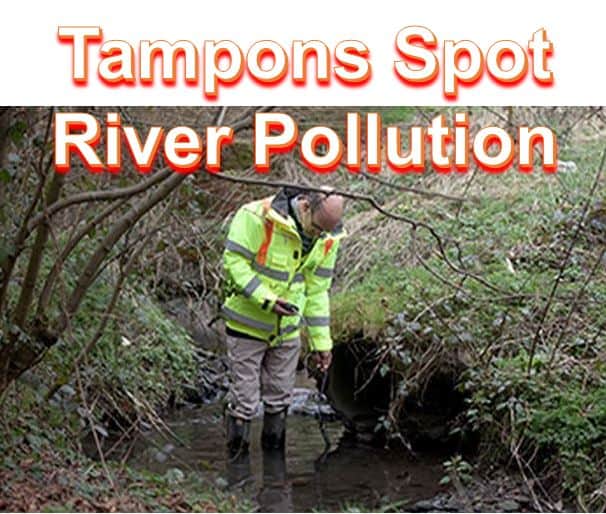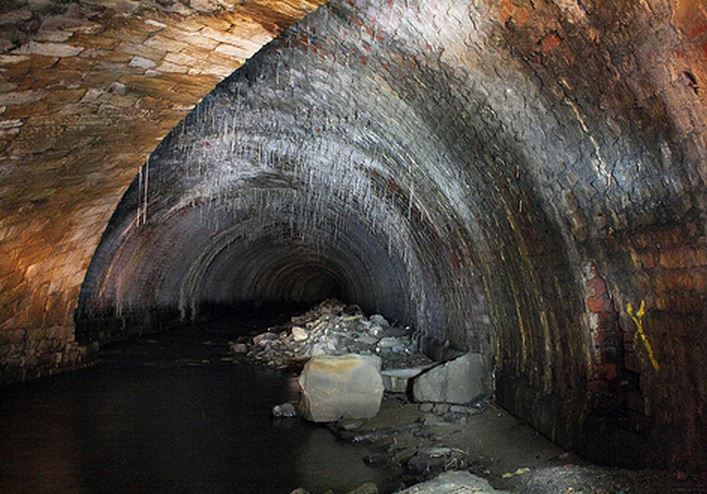When tampons absorb chemicals commonly found in river pollutants they glow under ultra-violet light. Engineers from the University of Sheffield are using them to determine which rivers and streams are sewage free, which are not, and where the problem originates.
The natural cotton inside tampons absorbs chemicals used in toilet paper, shampoos and laundry detergents. These ‘optical brighteners’, which are used to make colours brighter and white whiter, show up under ultra-violet (UV) light. Some clothing containing optical brighteners glow in certain bars and clubs.
In this latest study, scientists from the University of Sheffield’s Faculty of Engineering showed that when tampons are dipped in water containing tiny traces of detergents or sewage, they will pick up optical brighteners and glow when UV light is shone at them.

Prof. Lerner carrying out pollution tests in a stream using tampons and UV light. (Image: University of Sheffield)
They wrote about their study in the Water and Environment Journal (reference at end of article).
Tampons may help find 1m badly connected homes
Professor David Lerner, who led the study, said:
“More than a million homes have their waste water incorrectly connected into the surface water network, which means their sewage is being discharged into a river, rather than going to a treatment plant.”
“Unfortunately, it’s very difficult to detect where this is happening, as the discharge is intermittent, can’t always be seen with the naked eye and existing tests are complex and expensive.”
“The main difficulty with detecting sewage pollution by searching for optical brighteners is finding cotton that does not already contain these chemicals. That’s why tampons, being explicitly untreated, provide such a neat solution. Our new method may be unconventional – but it’s cheap and it works.”
Stage I – A laboratory trial
In laboratory trials, aimed at determining what detergent concentrations are needed before the tampons start to glow, the researchers found that the minimum solution was 0.01 ml of detergent per litre of water, which is over 300 times more diluted than levels commonly found in a surface water pipe.
The tampons, which had been submerged in the solution for five seconds, carried on glowing under UV light for about thirty days.
Stage II – A field trial
The research team then carried out a field trial. They placed tampons in sixteen different surface water outlets that flowed into rivers and streams in Sheffield for three days, and then shone UV light on them.
Tampons that had been placed in nine water outlets glowed, showing that those outlets were polluting the river or stream.
They then teamed up with Yorkshire Water to try to find out where in each case the problem originated. They worked backwards along the pipe network along four of the nine polluted outlets, dipping a tampon into the water at each manhole.
In every case, they managed to isolate the sections where the sewage was seeping in, identifying the homes that would need to be inspected more carefully.
A visual inspection in one area revealed a household where both a sink and soil stack had been connected to the wrong sewer.

Prof. Lerner and colleagues plan to perform a larger field trial on the Bradford Beck.
Tampons better and faster than a dye test
Prof. Lerner said:
“Often the only way to be sure a house is misconnected is through a dye test – putting dye down a sink or toilet and seeing where the coloured water appears in the sewer.”
“It’s clearly impractical for water companies to do this for all the households they supply, but by working back from where pollution is identified and narrowing it down to a particular section of the network, the final step of identifying the source then becomes feasible.”
Rivers and streams contaminated with pollutants end up with rapidly-multiplying pollutant-tolerant species of bacteria and invertebrates, which lead to an accumulation of ‘sewage fungus’, seen as a grey lining on the river bed.
Rivers contaminated with sewage can also harbor several pathogens (organisms that cause diseases), including norovirus.
Most home-owners, landlords and tenants whose properties are badly connected don’t know they are discharging waste water into the wrong system.
Stage III – A larger field trial
Now that Prof. Lerner and colleagues have shown that the glowing-tampon method works in practice in the field, they plan to carry out a larger trial on the Bradford Beck, the river that runs through the city of Bradford.
The study was financed by the Engineering and Physical Sciences Research Council (EPSCR) and Yorkshire Water.
Reference: Dave Mark Chandler and David Nicholas Lerner. “A low cost method to detect polluted surface water outfalls and misconnected drainage.” Water and Environment Journal. Published 31 March, 2015. DOI: 10.1111/wej.12112.
